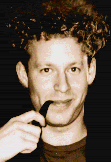Interfacing Telerobotics to the Net: Experiments in Telepistemology
 Ken Goldberg,
UC Berkeley
Ken Goldberg,
UC Berkeley
goldberg@ieor.berkeley.edu
Seminar on People, Computers,
and Design
Stanford University January 29, 1999
What is the relation between distance and knowledge in the context of technology? As exemplified by the telescope, telephone and television, technology has often been used to bridge distances. Recent examples include the Mars Sojourner, the atomic force microscope, and lapariscopic surgery. Remote control technologies permeat our daily lives: we have remote controls for the garage door, the car alarm, and the television (the latter a remote for the remote). Global networks extend these capabilities with cellular phones, teleconferencing, and telecommuting. In this talk, I will focus on the interfaces that permit cameras and mechanical robots to be remotely operated over the Internet.
As our reach is extended, we are vulnerable to error, deception and forgery. How do we distinguish reality from illusion? What can we know? I propose the term ``telepistemology'' to refer to this subclass of epistemological questions.
In the past 4 years, my students and I have developed five telerobotic installations on the WWW. One example is the Telegarden, an installation that allows WWW visitors to view and interact with a remote garden filled with living plants. The most recent is the Shadowserver. I'll discuss these projects and our experience in trying to develop believable interfaces.
Ken Goldberg (goldberg@ieor.berkeley.edu) is Assoc Professor of Engineering and founder of the Art, Technology, and Culture Colloquium at UC Berkeley. He received his PhD in 1990 from the School of Computer Science at Carnegie Mellon University. Goldberg and his students study geometric algorithms for feeding, sorting, and fixturing industrial parts. In 1994, Goldberg led the team that developed the first telerobotic World Wide Web art installation; his projects have since won juried awards at the Interactive Media Festival, the Festival for Interactive Arts, New Voices/New Visions, and the National Information Infrastructure Awards. Goldberg serves on the Advisory Board of the IEEE Society of Robotics and Automation. and has given invited lectures on telerobotic art at MIT Media Lab, CMU, NYU, and the NY School of Visual Arts. He was named a National Science Foundation Young Investigator in 1994 and NSF Presidential Faculty Fellow in 1995. He is currently editing a book on Internet Telepistemology for MIT Press.
Titles and abstracts for all years are available by year and by speaker.
For more information about HCI at Stanford see